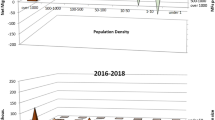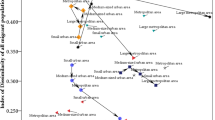Abstract
Recent literature regarding population migration and urbanisation patterns in Sub-Saharan Africa indicates that migration patterns are far more complex than originally suggested, with evidence of counterurbanisation and reurbanisation patterns. Furthermore, migration patterns are strongly affected by diverse economic and policy pressures which often have unintended adverse effects on population movements. To this end, the study analyses long-term population migration and industry agglomeration patterns between 1996 and 2011 to evaluate the effects of economic growth and policy in population movements in post-apartheid South Africa. Moreover, the study disaggregates subpopulations in categories of age, ethnicity, income and education, enabling researchers to understand contradictory mainstream and substream migration trends based upon differential urbanisation theory. The study also debates the spatial effects of economic and social migration motivations on migration patterns in South Africa. The study reveals strong mainstream urbanisation patterns occurring amongst the lower skilled and black South African subpopulations. Substream counterurbanisation processes are also occurring with smaller subpopulations, particularly highly skilled, employed and white South African subpopulations. The Industry and capital are becoming more widely distributed, indicating possible polarisation reversal patterns. Finally, the study indicates that the trajectories are similar and that in the long run, different subpopulations are moving towards a more evenly and less spatially fragmented urban landscape.








Similar content being viewed by others
References
Africapolis. (2008). Urbanization trends 1950–2020: a geo-statistical approach. West Africa: Fact Sheets by Country.
Baldwin, R., Forslid, R., Martin, P., Ottaviano, G., & Robert-Nicoud, F. (2003). Economic geography and public policy. Princeton: Princeton University.
Becker, C., Hamer, H., & Morrison, A. (1994). Beyond urban bias in Africa: urbanisation in an era of structural adjustment. London: Currey.
Bhorat, H., & Oosthuizen, M. (2006). Evolution of the labour market: 1995–2002. In H. Bhorat & R. Kanbur (Eds.), Poverty and policy in post-apartheid South Africa (pp. 143–200). Cape Town: HSRC.
Bosch, A., Rossouw, J., Claassens, T., du Plessis, B. (2010). A second look at measuring inequality in South Africa: a modified Gini coefficient. School of Development Studies Working Paper, 58. University of KwaZulu-Natal.
Champion, A. (2001). Urbanization, suburbanization, counterurbanization and reurbanization. In R. Paddison (Ed.), Handbook of urban studies (pp. 143–161). London: Sage.
Collinson, M., Kok, P., & Garenne, M. (2006). Migration in changing settlement patterns: multilevel data for policy. Portsmouth: Heinemann.
Cross, C. (2006). Migrant motivations and capacities in relation to key migration streams. In P. Kok, D. Gelderblom, J. O. Oucho, & J. Van Zyl (Eds.), Migration in South and Southern Africa: dynamics and determinants (pp. 205–226). Cape Town: HSRC.
Crush, J., & Frayne, B. (2007). The migration and development nexus in Southern Africa. Development Southern Africa, 24(1), 1–21.
Ferguson, J. (1999). Expectations of modernity: myths and meanings of urban life on the Copperbelt. Los Angeles: University of California.
Geyer, H. (1990). Implications of differential urbanization on deconcentration in the Pretoria-Witwatersrand-Vaal Triangle metropolitan area, South Africa. Geoforum, 21(1), 385–396.
Geyer, H. (1996). Expanding the theoretical foundation of differential urbanization. Tijdschrift voor Economische en Sociale Geografie, 87(1), 44–59.
Geyer, H. S. (2002). The Fundamentals of urban economic space. In H. S. Geyer (Ed.), International Handbook of urban systems: Studies of urbanization and migration in advanced and developing countries (pp. 219–228). Cheltenham: Edward Elgar.
Geyer, H., & Kontuly, T. (1996). A theoretical foundation for the concept of differential urbanization. In N. Hansen, K. Button, & P. Nijkamp (Eds.), Regional policy and regional integration, vol. 6 of modern classics in regional science (pp. 219–228). Cheltenham: Edward Elgar.
Geyer, H., Jr., Geyer, H., du Plessis, D., & van Eeden, A. (2012). Differential urbanisation trends in South Africa—regional and local equivalents. Environment and Planning A, 44(12), 2940–2956.
Geyer, H. Jr., Geyer, H., du Plessis, D. (In Press). Primary cities in Sub-Saharan Africa: Quasars, Loose Connections, and Black Holes. International planning studies (forthcoming)
Grant, R. (2010). Working it out: labour geographies of the poor in Soweto, South Africa. Development Southern Africa, 27(4), 595–612.
Hart, T. (1983). Transport and economic development: the historical dimension. In K. Button & D. Gillingwater (Eds.), Transport, location and spatial policy (pp. 12–22). Aldershot: Gower.
Klaassen, L., & Scimeni, G. (1981). Theoretical issues in urban dynamics. In L. Klaassen, W. Molle, & J. Paelinck (Eds.), Klaassen, L., & Scimeni, G. (1981). Theoretical issues in urban dynamics. In L. Klaassen Molle, W., Paelinck, J. (Eds.), Dynamics of urban development (pp. 8–28). Aldershot: Gower.
Kok, P., Donovan, M., Bouare, O., & Van Zyl, J. (2003). Post-apartheid patterns of internal migration in South Africa. Cape Town: HSRC.
Kontuly, T. M., & Geyer, H. (2003). Introduction to special issue: testing the differential urbanization model in developed and less developed countries. TESG/Journal of Social and Economic Geography, 94(1), 1–17.
Lee, H. (1989). Growth determinants in the core-periphery of Korea. International Regional Science Review, 12(2), 147–163.
Posel, D. (2003). The collection of the national household survey data in South Africa 1993–2001: rendering labour migration invisible. Development Southern Africa, 20(3), 361–368.
Potts, D. (2005). Counter-urbanisation on the Zambian Copper Belt? Interpretations and implications. Urban Studies, 42(4), 583–609.
Potts, D. (2012). Whatever happened to Africa’s rapid urbanisation? London: Africa Research Institute.
Richardson, H. (1973). Economic growth theory. London: Macmillan.
Richardson, H. (1980). Polarization reversal in developing countries. Papers of the Regional Science Association, 45(1), 67–85.
Rosen, K., & Resnick, M. (1980). The size distribution of cities: an examination of the Pareto Law and Primacy. Journal of Urban Economics, 8(1), 165–186.
Soo, K. (2005). Zipf’s Law for cities: a cross-country investigation. Regional Science and Urban Economics, 35(1), 239–263.
Todes, A., Kok, P., Wentzel, M., Van Zyl, J., & Cross, C. (2010). Contemporary South African urbanization dynamics. Urban Forum, 21(1), 331–348.
Wentzel, M., Viljoen, J., & Kok, P. (2006). Contemporary South African migration patterns and intentions. In P. Kok, D. Gelderblom, J. O. Oucho, & J. Van Zyl (Eds.), Migration in South and Southern Africa: dynamics and determinants (pp. 171–204). Cape Town: HSRC.
Acknowledgments
The authors are grateful to the anonymous reviewers for their constructive comments in the earlier versions of this paper.
Author information
Authors and Affiliations
Corresponding author
Rights and permissions
About this article
Cite this article
Geyer, H.S., Geyer, H.S. Disaggregated Population Migration Trends in South Africa Between 1996 and 2011: a Differential Urbanisation Approach. Urban Forum 26, 1–13 (2015). https://doi.org/10.1007/s12132-014-9229-1
Published:
Issue Date:
DOI: https://doi.org/10.1007/s12132-014-9229-1




